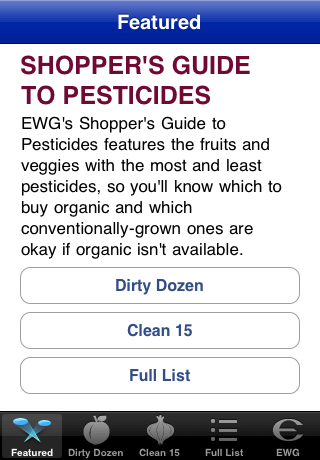Shopper's Guide to Pesticides iPhone App
3 years ago, I mentioned a handy list of produce ranked by how much pesticide is used to grow them. The higher (=more pesticides) the ranking, the better it would be to stick to organically grown.
I recently got a new iPhone (yes...I'm the very opposite of an Early Adopter of tech gadgets) and discovered that the same list is available as a free iPhone app called DirtyProduce. Here's a screenshot of the opening page:

It doesn't do much beyond list the Dirty Dozen (the most heavily pesticide-treated fruits and vegetables), the Clean 15 (the last pesticide-used) and the full list of 47 produce items, but it's handy to have around with you. Who knew for instance that peaches were the most pesticide-laden fruit or vegetable? I tend not to peel my peaches, and I ate, oh I don't know, a few tons of them over the summer. I may start peeling them next season, or look for non-treated ones.
Anyway, if you do have an iPhone, take a look. And if you don't, there is still the PDF list to print out and carry in your wallet.
If you enjoyed this article, please consider becoming my patron via Patreon. ^_^

 Welcome to Just Hungry, where we serve authentic Japanese recipes and more! I'm
Welcome to Just Hungry, where we serve authentic Japanese recipes and more! I'm 














Comments
wintersweet is ...
5 October, 2009 - 23:15
Permalink
Re: Shopper's Guide to Pesticides iPhone App
Heh, I can't afford an iPhone yet, but I might get an iPod Touch for my birthday. :p That's a cool application--it's hard to remember everything! Another one that I'd like to download someday is the seafood one from the Monterey Bay Aquarium, which includes sushi and sashimi info.
I think it's better to try to buy organic or pesticide-free produce rather than to peel everything--a lot of fruits and vegetables stash their nutrients and fibers in the peel. I don't know about peaches in particular, but...
At our farmer's market a number of the farmers don't have organic certification for various reasons but don't use harmful pesticides anyway, so you can just talk to them about what they use and why. :)
(doing paperwork and too busy to log in!)
Beth Cunningham
7 October, 2009 - 18:50
Permalink
Re: Shopper's Guide to Pesticides iPhone App
Thanks for your information on the various lists to be aware of regarding pesticides. I really do not share your fear of how pesticides are used but it is interesting to have the different levels nonetheless. casino online
Sun
11 October, 2009 - 09:45
Permalink
Re: Shopper's Guide to Pesticides iPhone App
Thanks for the tip! I just got an iPhone last week. Ooh, and the Monterey Bay Aquarium seafood watch one is a great tip, too!
kirsty_girl
18 October, 2009 - 03:09
Permalink
Re: Shopper's Guide to Pesticides iPhone App
Thanks for the info. Downloading the app now.
Enjoy the iPhone!
SteveS
26 October, 2009 - 23:26
Permalink
Re: Shopper's Guide to Pesticides iPhone App
I've seen this list before and, curious about the methodology, tracked down some of the "87,000 DoA and FDA tests" that they used. Here's a sample, from '04:
http://www.fda.gov/Food/FoodSafety/FoodContaminantsAdulteration/Pesticid...
As you can see, there are massive differences in the sizes of sample groups; while there were 194 tests on apples (#2 ranked dirty produce), there were only 4 tests done on avocados (#2 ranked clean produce). You simply can't tell anything about avocados from that small a data set, and any comparison between the two is meaningless. It's possible that the Department of Agriculture's tests are more evenly distributed, and maybe their iPhone app lists the number of tests used to rank each category of produce. But from what little I've seen of the statistics they used, it looks like bad science.
SteveS
5 November, 2009 - 16:28
Permalink
Re: Shopper's Guide to Pesticides iPhone App
Not that anyone asked, but the USDA's test data is even less useful in comparing different varieties of produce. While the FDA tests every category every year--in unbalanced quantities--the USDA tests focus exclusively on a few kinds of produce each year. While that evens out the number of tests--except for things like avocados, which aren't on their schedule at all--it introduces even more problems when comparing types of produce: now, you're not only comparing different numbers of tests for celery and onions, but the different years that each were tested. And many other factors could affect test results year-to-year: humidity, temperature, pesticide regulations, the materials/techniques/personnel involved in testing.
SteveS
10 November, 2009 - 19:12
Permalink
Re: Shopper's Guide to Pesticides iPhone App
Mind you, all of that isn't to say that the list is useless--a flawed study gives better information than no study at all.
And the people at EWG seem very nice--they responded multiple times to my increasingly-nerdy emails, and pointed me to the USDA and FDA study data. It was more patience than I had expected. So they're probably not shills for the avocado growers' association or whatever, which was my main concern when I started looking at the FDA data.
Anyway, please keep in mind that the data behind this list is pretty uneven. The scary thing is that the trend seems to be: the more pesticide-laden a category of produce is on the list, the more solid the data on it seems to be.
snore stop
27 January, 2014 - 12:26
Permalink
Re: Shopper's Guide to Pesticides iPhone App
I guess it is better to have an iPhone app rather than going around holding a pdf printout of the list. This will certainly help us to make a better choice about the food that we eat and to select organic food products and to stay healthy.